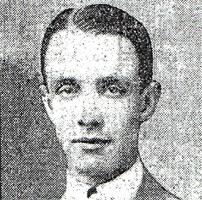Oliver Percy Bernard

Oliver Percy Bernard OBE MC (8 April 1881 – 15 April 1939) was an English architect, and scenic, graphic and industrial designer. He was instrumental in developing conservative Victorian British taste in a modernist European direction and much of his work is frequently characterised as art deco.
Contents
Early life
Born in Camberwell, London, Bernard was the son of Charles (formerly Charles West, died 1894), a theatre manager, and his wife Annie Allen, an actress. He experienced an unhappy childhood in London and, on the death of his father in 1894, left for Manchester to take a job as a theatre stage hand. He took on his own education by reading John Locke, John Ruskin and others. He ultimately took a series of menial jobs at sea, before returning to London to take up scene painting with Walter Hann. He filled his recreation with boxing and billiards. In 1905, he went to New York to work for Klaw & Erlanger before returning to London to work at Covent Garden.[1] In 1912 he was scenic director of the Quinlan Opera Company during their tour of Australia.[2]
At the beginning of World War I in 1914, he was rejected for military service on the grounds of his deafness. Now frustrated by the conservatism of the London theatre,[1] and ashamed at his inability to serve in the war,[3] Bernard travelled back to the U.S. before returning on the RMS Lusitania in 1915, surviving its sinking.[1] As the ship went down, Bernard made sketches which were published in the Illustrated London News.[4] However, in 1916, he was commissioned into the Royal Engineers as a camouflage officer, serving in France, Italy and Belgium, reaching the rank of Captain, and being awarded the Military Cross and OBE.[1]
Post-war
In 1919, he continued his theatrical work, designing sets for Sir Thomas Beecham's Ring Cycle at Covent Garden. He also overhauled lighting and stage management at the Admiralty Theatre.[1]
However, his work was also moving to display an interest in trade and industry, new materials and techniques and a populist approach to decoration. He acted as consultant to the Board of Overseas Trade and worked on designing displays for the British Empire Exhibition in 1924. He was a consultant again to the British government for the 1925 Exposition Internationale des Arts Décoratifs et Industriels Modernes in Paris.[1] His work is sometimes characterised among the Streamline Moderne.[citation needed]
J. Lyons and Co.
He was consultant artistic director to J. Lyons and Co., defining much of their later house style and designing interiors for their Oxford Street, Coventry Street, and Strand Corner Houses.[1]
In 1929, he designed a spectacular art deco entrance to the Strand Palace Hotel and worked on the Cumberland Hotel in 1932.[1]
Later work
Bernard also wrote on design and architecture and championed the exploitation of engineering expertise. He worked on furniture design and, from the late 1930s designed a number of industrial buildings, most notably the Supermarine works in Southampton.[1] He was involved in founding PEL (Practical Equipment Ltd) and designed the S.P.4 chair for them.[5][6]
Personality and family
Bernard was "short in stature with a large head." His former secretary described him as "amusing, utterly impossible, kind, and a bully".[1]
Bernard was married twice:
- Muriel Theresa Lightfoot (born 1884/5), singer (1911-1924);[1]
- (Edith) Dora Hodges (stage name Fedora Roselli, 1896-1950), opera singer (1924-).[1] The couple had two daughters and three sons including:
- Oliver Bernard, poet and translator. Oliver attended Westminster School and published a book of memoirs;[7][8]
- Bruce Bonus Bernard, photographer and art critic;[1] and
- Jeffrey Bernard, journalist.[1]
Bernard died unexpectedly of peritonitis in London.[1] His estate was worth £2,950 at his death[1] but he left his wife with heavy debts.[8] Nevertheless, she managed to send the three sons to independent schools.[8]
References
- ↑ 1.00 1.01 1.02 1.03 1.04 1.05 1.06 1.07 1.08 1.09 1.10 1.11 1.12 1.13 1.14 1.15 Powers (2004)
- ↑ Gyger
- ↑ Wang (2003-2005)
- ↑ Reproduced in Sauder & Marschall (1993) pp46-47
- ↑ Powers (2007)
- ↑ Parker (1984)
- ↑ Bernard (1992)
- ↑ 8.0 8.1 8.2 May, A. (2004) "Bernard, Bruce Bonus (1928–2000)", Oxford Dictionary of National Biography, Oxford University Press, accessed 22 August 2007 subscription or UK public library membership required
Bibliography
- Bernard, O. (1936). Cock Sparrow: A True Chronicle. London.
- Bernard, O. [junior] (1992). Getting Over It: Recollections. London: Peter Owen. ISBN 0720608651.
- Gyger, Alison (1990). Opera for the Antipodes (Opera in Australia 1881-1939). Sydney: Currency Press and Pellinor Pty Ltd. ISBN 0-86819-268-6.
- Links, J. G. (1985). "Oliver Bernard, the Barbican and me". 30s Society Journal 5: 2–7.
- Parker, E. (1984). "Working for Oliver Bernard and the early days of PEL Ltd". Journal of the Decorative Arts Society 8: 50–57.
- Powers, A. (2004) "Bernard, Oliver Percy (1881–1939)", rev., Oxford Dictionary of National Biography, Oxford University Press, accessed 22 August 2007 subscription or UK public library membership required
- — (2007) "Bernard, Oliver (Percy)", Grove Art Online, Oxford University Press, accessed 22 August 2007 (subscription or UK public library membership required)
- Sauder, E. & Marschall, K. (1993). R. M. S. Lusitania: Triumph of the Edwardian Age. Shipping Books Press. pp. pp46–47. ISBN 0946184801.
- Wang, R. J. (2003-2005). "Mr. Oliver Percy Bernard, Saloon Class Passenger". The Lusitania Resource. http://web.rmslusitania.info:81/pages/saloon_class/bernard_oliver.html. Retrieved 2007-08-22.
External links
- "Strand Palace". Art Deco: 1910-1939. Victoria and Albert Museum. http://www.vam.ac.uk/vastatic/microsites/1157_art_deco/about/strand/. Retrieved 2007-08-22.
- "S.P.4 chair". The Magazine.info. http://themagazine.info/products/-/265.html. Retrieved 2007-08-22.
- All articles with unsourced statements
- Articles with unsourced statements from August 2007
- Articles with invalid date parameter in template
- 1881 births
- 1939 deaths
- People from Camberwell
- English architects
- English designers
- Art Deco architects
- Officers of the Order of the British Empire
- RMS Lusitania
- British Army personnel of World War I
- Royal Engineers officers
- Recipients of the Military Cross
- Deaths from peritonitis
- Art Deco designers
